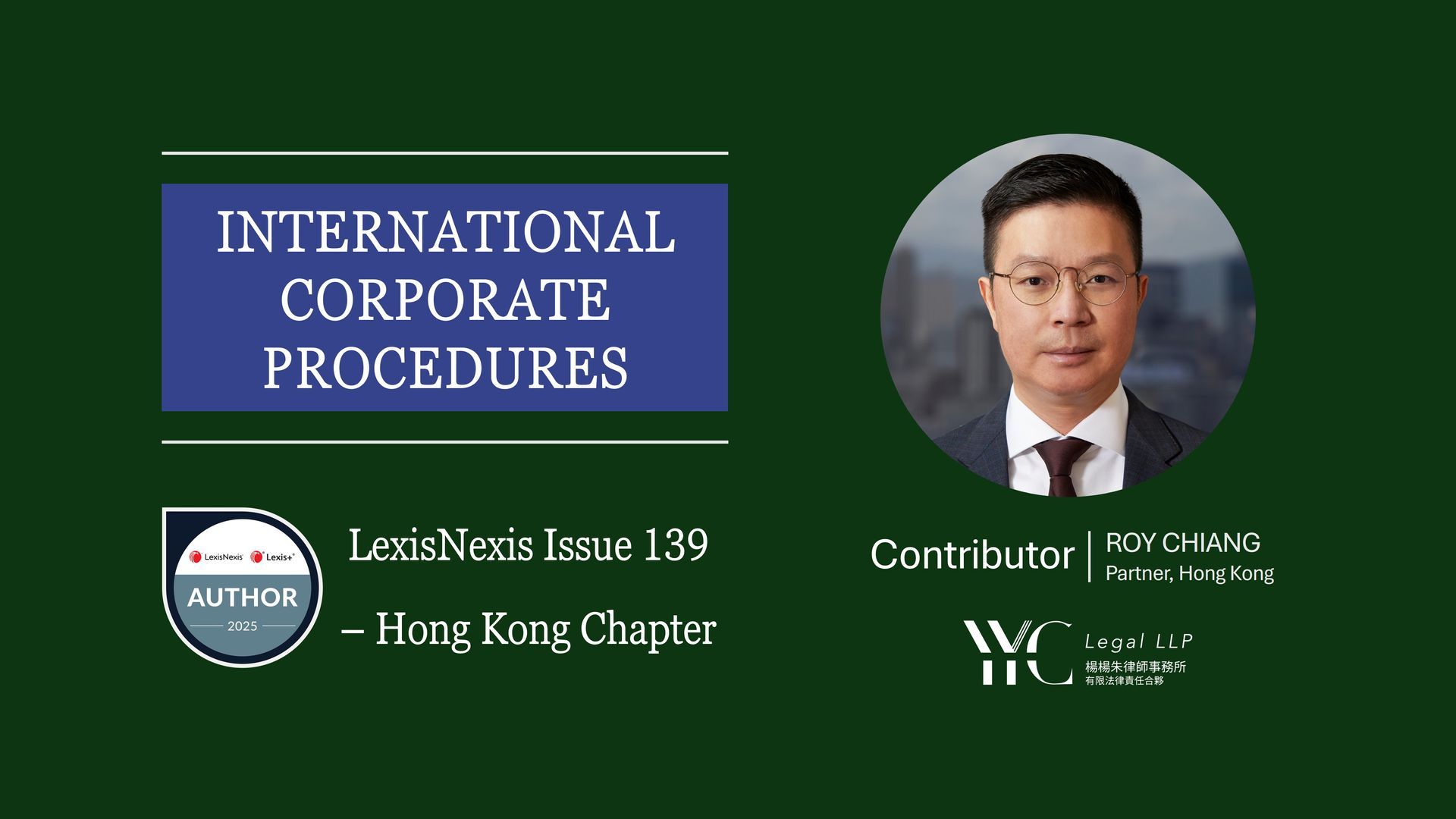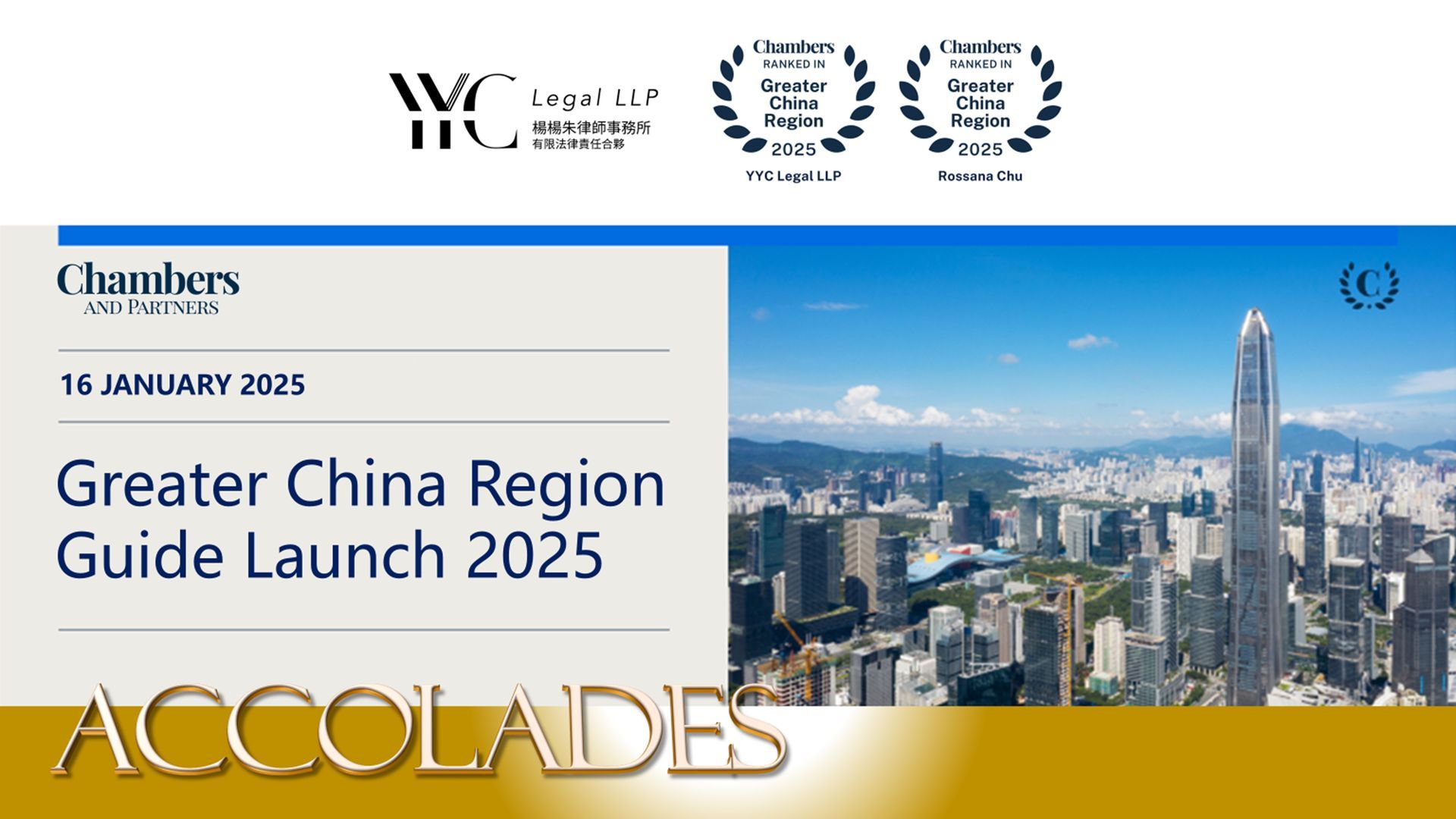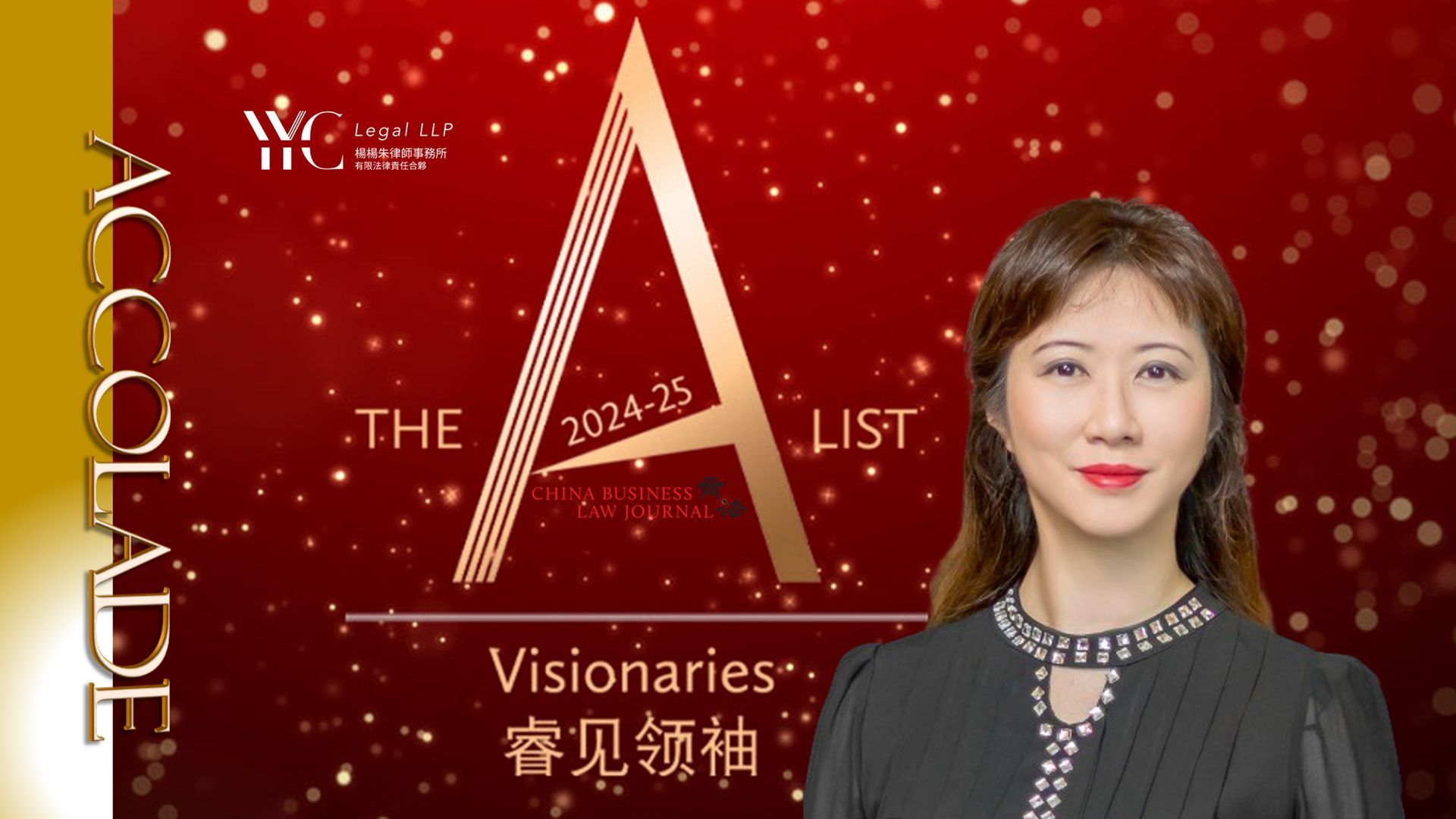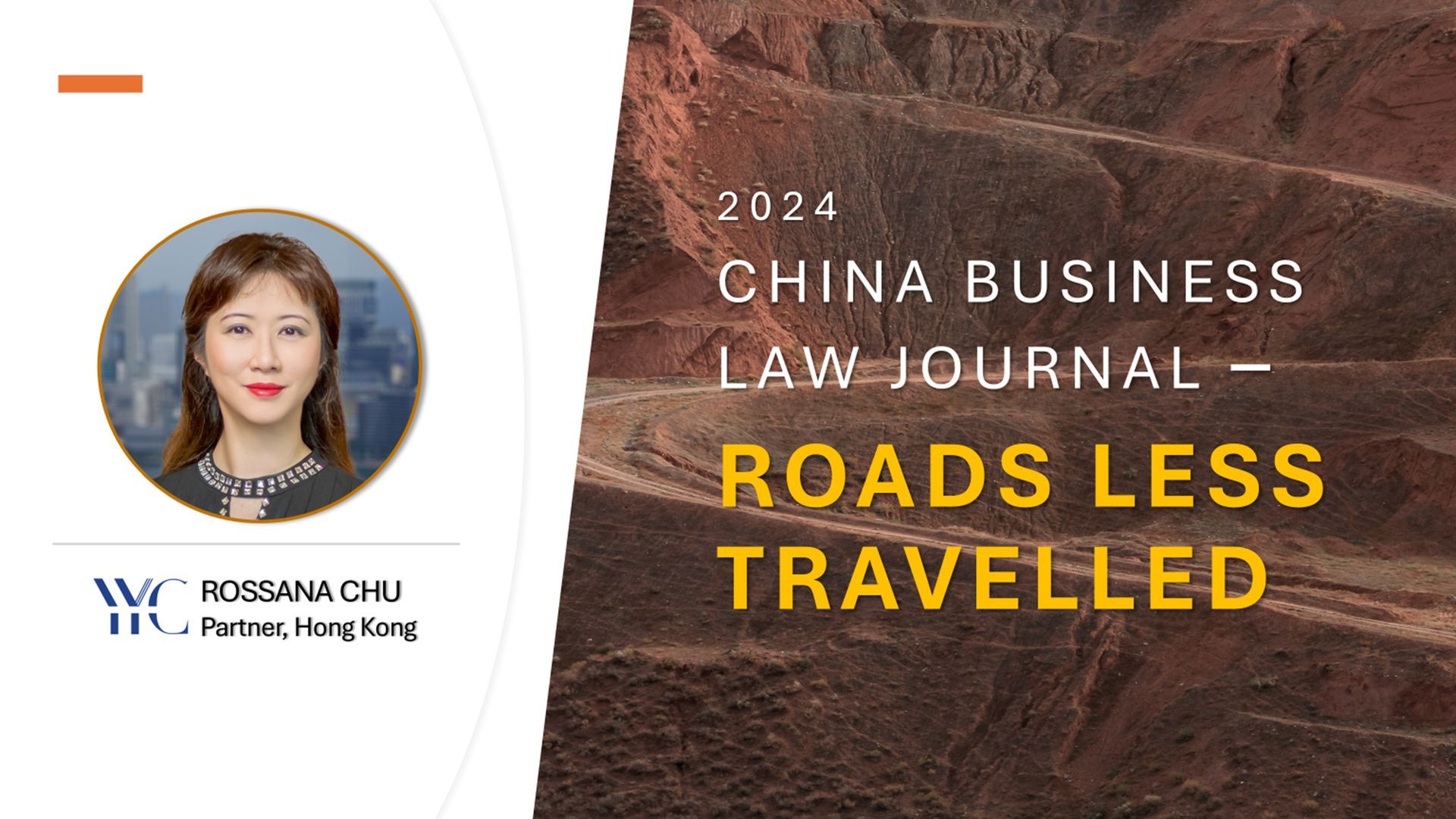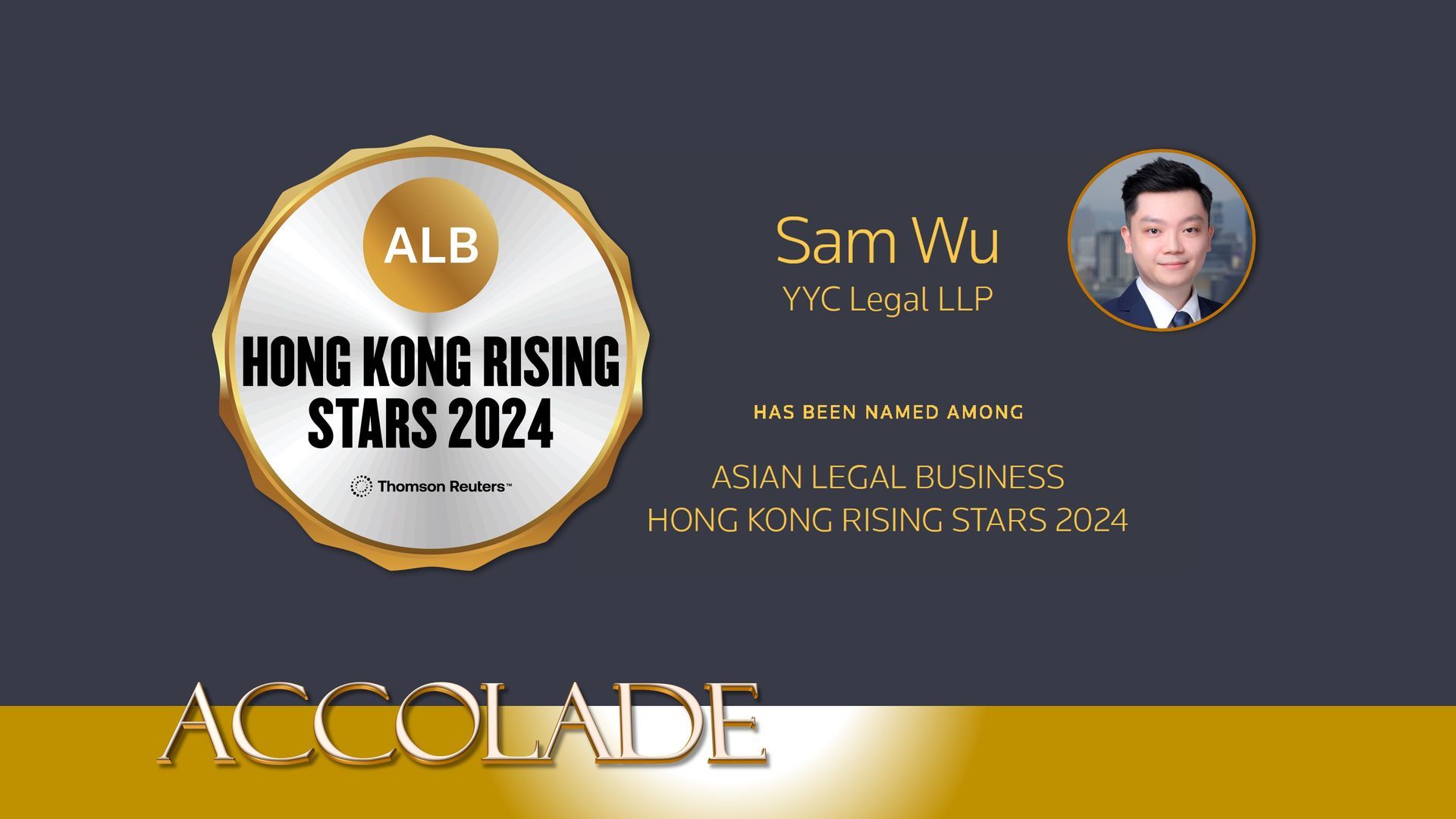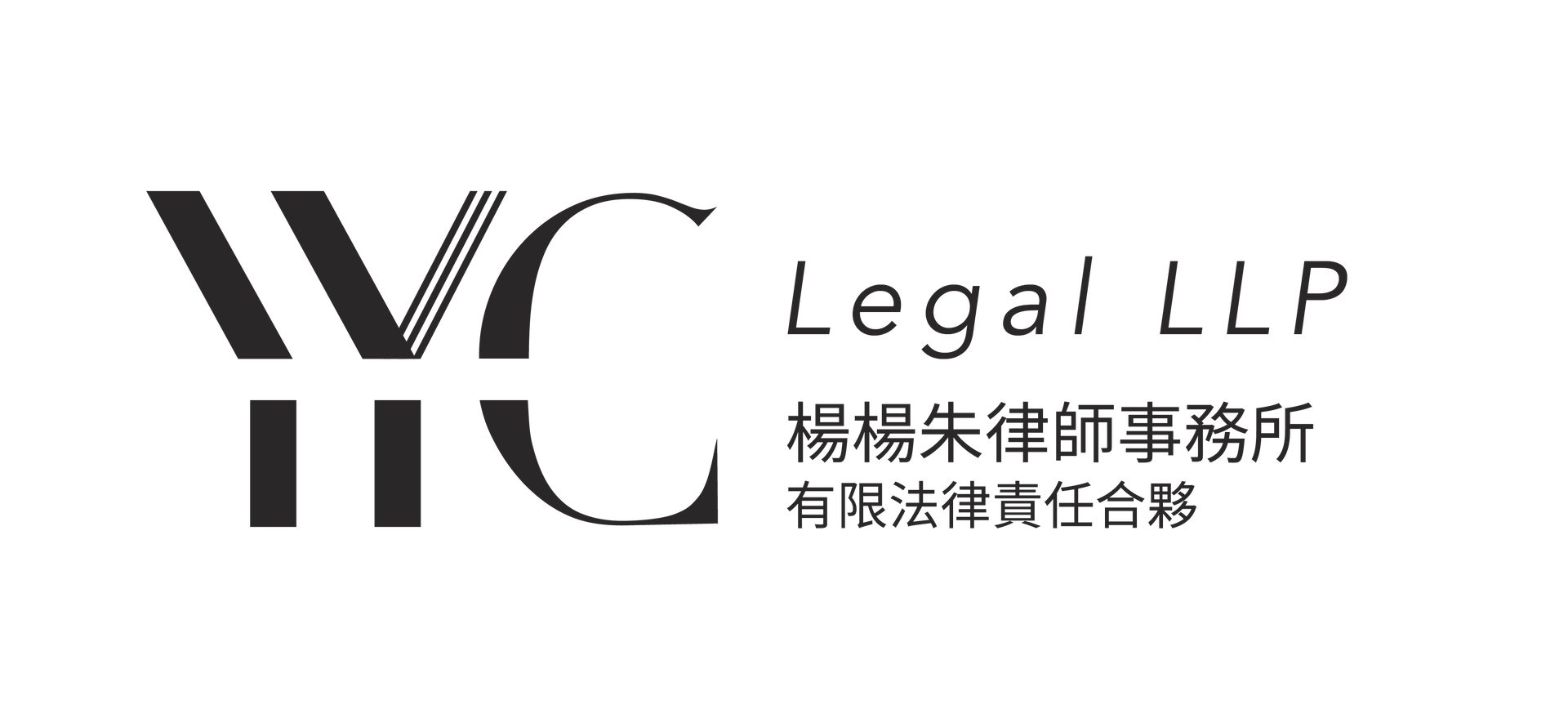
Address
China Resources Building, Wan Chai District, Hong Kong Hong Kong SAR
Get in touch
Chambers Global Practice Guides: Equity Finance 2024 – Hong Kong Chapter
Rossana Chu
Partner, Hong Kong
Dennis Yeung
Partner, Hong Kong
Sam Wu
Partner, Hong Kong
Beverly Fu
Associate, Hong Kong
Chambers Global Practice Guides: Equity Finance 2024 – Hong Kong Chapter
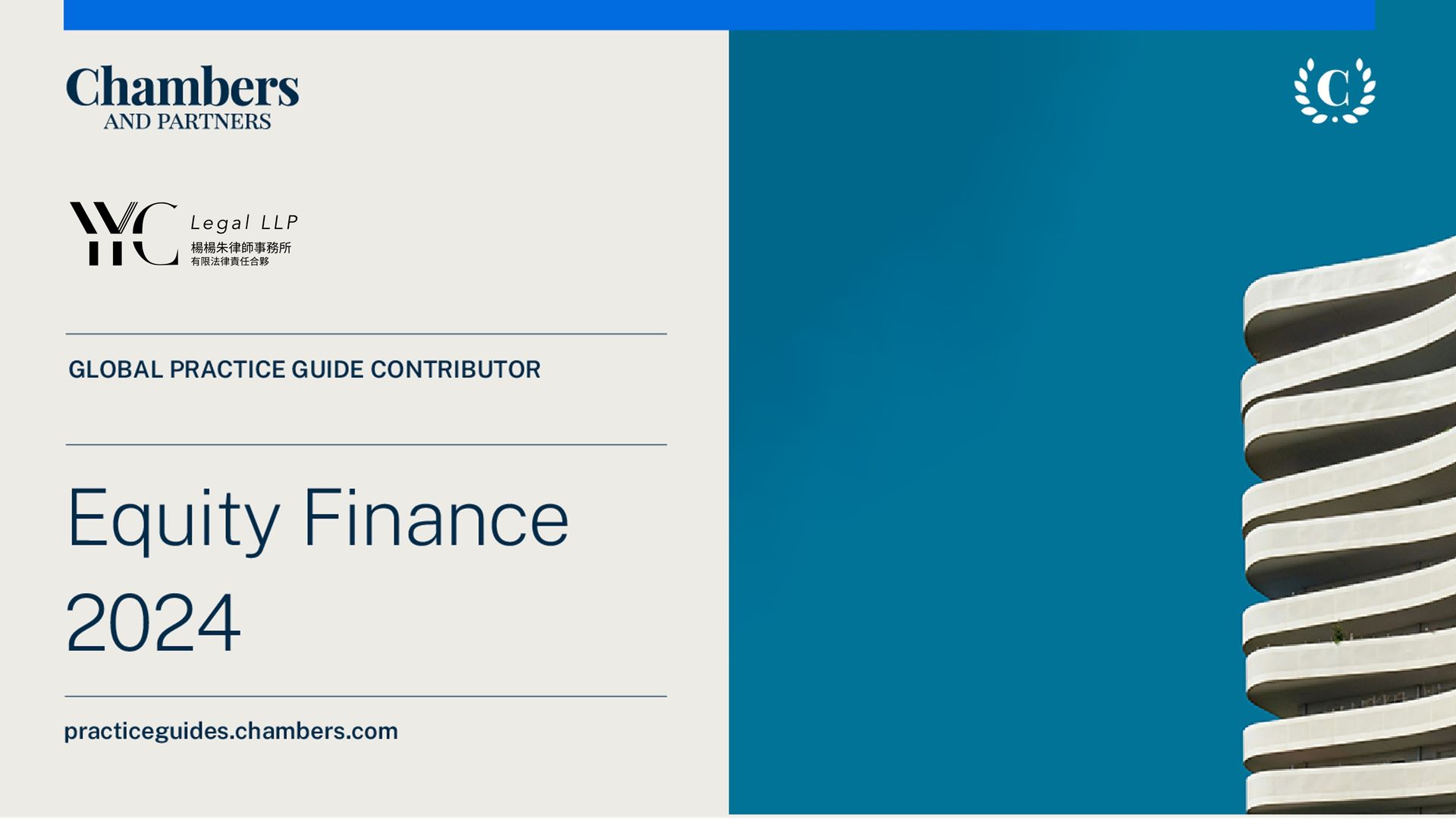
Our partners Rossana Chu, Dennis Yeung, and Sam Wu, together with associate Beverly Fu, of our leading corporate practice team, have co-authored the Hong Kong Chapter of the Chambers Global Practice Guides: Equity Finance 2024 to discuss the key trends and developments of the Hong Kong capital markets.
The Chambers Global Practice Guides
The Chambers Global Practice Guides provide updated expert legal commentary on the main legal practice areas in key jurisdictions around the world. The guides focus on the practical legal issues affecting businesses and enable readers to compare legislation, procedure, trends and developments across a range of key jurisdictions.
Equity Finance 2024
In today’s interconnected global economy, equity finance plays a crucial role in business growth, technological innovation and market expansion. The Equity Finance 2024 guide provides an in-depth exploration of the legal and regulatory framework for equity financing across various jurisdictions, including the USA, Japan, Germany, the UK, Brazil, Switzerland, Singapore, the Middle East, Hong Kong, Mexico and the UAE, as well as the key market trends and developments in those jurisdictions. By bringing together perspectives from leading legal experts, the Equity Finance 2024 guide aims to offer a comprehensive overview of equity finance, covering early-stage and growth investments, public markets and IPOs, regulatory and tax issues, and the impact of bankruptcy and insolvency on shareholders. The Equity Finance 2024 guide also aims to equip investors, companies and advisers with the insights needed to make informed decisions, seize opportunities and navigate the challenges of equity financing in an increasingly globalised economy.
To read our Hong Kong chapter for more details on the key trends and developments in the Hong Kong capital markets, please visit: https://practiceguides.chambers.com/practice-guides/equity-finance-2024/hong-kong-sar-china/trends-and-developments
To read the full eEdition of the Chambers Global Practice Guides: Equity Finance 2024, please visit:
https://gpg-pdf.chambers.com/view/110806924/
Introduction and Overview
Hong Kong has been one of the leading international financial centres in the world for the past decades. It is, however, facing challenges from factors such as geopolitics, market sentiment, high interest rates and macroeconomic backdrop. For example, in the first half of 2024, the initial public offering (IPO) market raised HK$11.6 billion, which is a decrease of 35% in funds raised compared to the first half of 2023.
Despite the challenges and difficulties, various measures have been implemented to enhance and strengthen the infrastructure of capital markets in Hong Kong in order to maintain market reputation and attract new capital.
Hong Kong’s Superconnector Status
In recent years, despite the complex macroeconomic landscape and geopolitical environment, Hong Kong and Mainland China (Mainland) have been launching a series of initiatives that reinforce and highlight Hong Kong’s role as the “Global Superconnector” between Mainland and the world, in particular through their respective capital markets in light of Mainland’s foreign exchange control and Hong Kong’s unique position as the only city in the world that converges both the Mainland advantage and the global advantage under the “One Country, Two Systems” infrastructure. Below is an overview of each of such initiatives.
Stock Connect
Stock Connect is a mutual market access scheme and investment channel through which investors in Mainland and Hong Kong can trade and settle securities listed on each other’s market through the stock exchanges and clearing houses in their home market. The Shanghai-Hong Kong Stock Connect was launched in 2014, followed by the Shenzhen-Hong Kong Stock Connect in 2016. These two Stock Connect channels opened up Mainland stock markets for Hong Kong and overseas investors (international investors) (Northbound) and Hong Kong stock markets for Mainland investors (Southbound). This also marks the start of a series of initiatives aiming to promote the two-way opening-up of the capital markets in Mainland and Hong Kong, cementing Hong Kong’s position as Mainland’s main capital markets hub, and paves the way for further opening up of Mainland’s capital account and RMB internationalisation in future.
Stock Connect has the following key features:
1. Eligible securities - not all listed securities are “eligible securities”:
- Northbound (international investors): Only eligible A shares and eligible exchange traded funds (ETFs) listed on Shanghai Stock Exchange (SSE) or Shenzhen Stock Exchange (SZSE) may be traded by international investors.
- Eligible A shares include (i) constituent stocks of the SSE A Share Index or the SZSE Composite Index that fulfil the eligibility criteria (daily average market capitalisation, daily average turnover, etc.); and (ii) A shares listed on SSE or SZSE that do not fulfil the eligibility criteria, but have corresponding H shares listed on the Hong Kong Stock Exchange (SEHK).
- Eligible ETFs include ETFs listed on SSE or SZSE that satisfy the eligibility criteria.
- Southbound (Mainland investors): Only selective stocks and ETFs listed on the Main Board of SEHK (not GEM, real estate investment trusts, structured products, etc.) may be traded by eligible Mainland investors.
- Eligible SEHK-listed stocks include (i) constituent stocks of the Hang Seng Composite LargeCap Index and Hang Seng Composite MidCap Index, and constituent stocks of the Hang Seng Composite SmallCap Index, which have a market capitalisation of not less than HK$5 billion; and (ii) H shares that are not included as constituent stocks of the relevant indices but which have corresponding A shares listed on SSE or SZSE.
- Eligible SEHK-listed ETFs include ETFs listed on SEHK that satisfy the eligibility criteria.
2. Investors eligibility -
- Northbound (international investors): Except for STAR Market (科创板) stocks of SSE and ChiNext (创业板) stocks of SZSE which may only be traded by institutional professional investors, all international investors (not Mainland investors) are allowed to trade eligible securities through Northbound Stock Connect.
- Southbound (Mainland investors): Only Mainland institutional investors and those individual investors who have RMB500,000 in their securities and cash accounts are allowed to trade eligible securities through Southbound Stock Connect.
3. Daily quotas -
Trading under each of the two Stock Connect channels is subject to a daily quota, which limits the maximum net buy value of cross-boundary trades under each channel.
4. Trading currency - All trading in Stock Connect will be done in RMB.
5. Expandability -
Stock Connect is being constantly expanded and upgraded since its first launch in 2014:
- 2018 – For each of the two Stock Connect channels, Northbound daily quota (for international investors) was increased from RMB13 billion to RMB52 billion; Southbound daily quota (for Mainland investors) was increased from RMB10.5 billion to RMB42 billion.
- 2019 – SEHK-listed weighted voting rights companies (e.g. Xiaomi and Meituan) were added to Southbound Stock Connect for Mainland investors.
- 2020 – SEHK-listed biotech companies were added to Southbound Stock Connect for Mainland investors.
- 2021 (January) – Mainland annuity funds were allowed to invest in Hong Kong stock markets through Southbound Stock Connect.
- 2021 (February) – Mainland STAR Market (科创板) stocks were added to Northbound Stock Connect for international investors.
- 2022 – ETFs were added as eligible securities.
- 2023 (August) – “Block trading” was introduced, which, once implemented, will allow investors to execute large-sized transactions at privately negotiated prices, providing price and execution certainty for large-sized deals.
- 2023 (June) – RMB counter was introduced, which offers investors (in particular Mainland investors under Southbound Stock Connect) the choice of trading SEHK-listed eligible securities in either HKD or RMB.
- 2024 – The eligibility criteria for inclusion of ETFs in Stock Connect was relaxed, expanding the scope of eligible ETFs.
Bond Connect
Bond Connect is another mutual market access scheme that enables Mainland investors and international investors to trade in each other’s bond markets. Northbound trading commenced in 2017, offering China Interbank Bond Market access to international investors. Southbound trading was launched in 2021, providing a channel for Mainland institutional investors to invest in offshore bonds through the Hong Kong bond market.
Swap Connect
Building on Bond Connect, the mutual access scheme between Mainland and Hong Kong interest rate swap markets (Swap Connect) was launched in 2023. As the world’s first derivatives mutual market access programme, Swap Connect provides a channel for investors to participate in financial derivatives markets in both Mainland and Hong Kong. Starting initially with a Northbound channel, international investors can trade and clear onshore RMB interest rate swaps in Mainland. It provides risk management tools for Mainland’s bond markets that are increasingly demanded by international investors trading onshore Mainland fixed income.
China Treasury Bond Futures
It was announced in 2023 that China Treasury Bond Futures contracts will be launched in Hong Kong. This was preceded by a steady increase in offshore investments in Mainland treasury bonds (T-bonds) via Bond Connect since its launch in 2017. The T-bond futures will provide a tool to hedge exposure to Mainland assets, and thus facilitating further participation by offshore investors in the Mainland T-bond market.
New Chapter 18C: Specialist Technology Companies
In a significant move to enhance Hong Kong’s standing as a global financial hub, Chapter 18C has been introduced to its Main Board Listing Rules. This new chapter, which took effect on 31 March 2023, is designed to provide a dedicated pathway for specialist technology companies which do not satisfy the usual profit or market capitalisation/revenue/cash flow listing criteria under Chapter 8 of the Main Board Listing Rules to list on the Main Board of SEHK. By facilitating the listing of high-growth, technology-driven companies, Chapter 18C seeks to attract a broader range of companies engaged in innovative industries to list in Hong Kong.
Eligible industries and listing criteria
Chapter 18C defines specialist technology companies as those primarily involved in the research, development and commercialisation of products or services in one of the five designated industries, namely (i) next-generation information technology; (ii) advanced hardware and software; (iii) advanced materials; (iv) new energy and environmental protection; and (v) new food and agriculture technologies.
The rules under Chapter 18C further distinguish between two types of specialist technology companies, namely (i) commercial companies; and (ii) pre-commercial companies.
To qualify for listing under Chapter 18C, specialist technology companies must meet specific financial and operational criteria. These requirements include minimum market capitalisation thresholds, revenue targets and research and development (R&D) expenditure levels.
Minimum market capitalisation thresholds
According to the rules under Chapter 18C, commercial companies must have an initial market capitalisation of at least HK$6 billion at the time of listing and pre-commercial companies must have an initial market capitalisation of at least HK$10 billion at the time of listing.
However, on 23 August 2024, the SEHK and the Hong Kong Securities and Futures Commission announced that the minimum market capitalisation requirements are reduced temporarily, effective from 1 September 2024 to 31 August 2027. For commercial companies, such requirement is adjusted from HK$6 billion to HK$4 billion. For pre-commercial companies, such requirement is adjusted from HK$10 billion to HK$8 billion.
Revenue targets
Commercial companies must have generated at least HK$250 million in revenue from their specialist technology business segments in their most recent audited financial year. Pre-commercial companies, on the other hand, are not subject to this revenue requirement but must demonstrate a clear and credible path to commercialisation. This flexibility allows earlier-stage companies with promising technologies to access public markets, even if they have not yet reached full commercial maturity.
R&D expenditure levels
- For commercial companies: at least 15% of the total operating expenditure
- For pre-commercial companies with revenue of at least HK$150 million but less than HK$250 million for the most recent audited financial year: at least 30% of the total operating expenditure
- For pre-commercial companies with revenue of less than HK$150 million for the most recent audited financial year: at least 50% of the total operating expenditure
The ratios have to be met on a yearly basis for at least two of the three financial years prior to listing; and on an aggregate basis over all three financial years prior to listing.
The roles of Sophisticated Independent Investors (SIIs) and independent price-setting investors
One of the most notable aspects of Chapter 18C is the requirement for specialist technology companies to secure pre-IPO investments from SIIs for at least 12 months before the date of listing application. These investors are expected to be sophisticated, independent, and have certain investment portion in the specialist technology sectors in their portfolio. This requirement serves several important functions, i.e., to ensure the specialist technology companies have been subject to extensive due diligence checks by the SIIs prior to listing and to ensure that there is sufficient independent market support for the specialist technology companies.
Additionally, Chapter 18C mandates that at least 50% of the total IPO shares must be allocated to independent price-setting investors in the placing tranche. This measure may facilitate the price discovery of specialist technology companies, mitigate risk of price volatility shortly after an IPO and safeguard retail investors.
Implications and recent developments
The introduction of Chapter 18C reflects broader global trends, where financial markets are increasingly focused on attracting companies from cutting-edge sectors such as renewable energy, artificial intelligence and advanced materials. Exchanges around the world are beginning to recognise the importance of high-growth, innovation-driven companies in shaping the future of the global economy.
Hong Kong’s approach under Chapter 18C is particularly noteworthy because it acknowledges that many of these companies, while technologically advanced, may not yet meet traditional financial metrics. By offering a bespoke listing framework that accommodates the unique growth trajectories of these specialist technology companies, the SEHK facilitates the development of next-generation industries in Hong Kong.
As of September 2024, at least two specialist technology companies have been listed under this new regime. The launch of Chapter 18C marks a watershed moment for Hong Kong’s financial ecosystem. As the global economy increasingly values technology, the ability to attract and support high-growth, innovation-driven companies is critical to maintaining Hong Kong’s status as a leading international financial centre.
GEM Listing Reforms
The SEHK has two markets, namely, the Main Board and GEM. The “Growth Enterprise Market”, being the former name of GEM, was introduced in 1999 to provide listing opportunities for emerging growth companies. In 2008, companies listed on the Growth Enterprise Market could be transferred to the Main Board in a streamlined way without having a sponsor to conduct very intense due diligence as long as the company fulfilled the Main Board listing criteria. Such streamlined mechanism was cancelled and the “stepping stone” role of the Growth Enterprise Market ended in 2018. Such market was renamed as “GEM” which was re-positioned as a stand-alone board for small and medium-sized enterprises.
Indeed, the Main Board has consistently served as the primary market for both IPOs and post-listing trading activities. The market capitalisation of all GEM-listed companies represents only a small fraction of the total market capitalisation of all Hong Kong listed companies. Since 2019 (i.e., after the streamlined transfer mechanism was removed), the number of IPOs and funds raised on GEM declined in a significant way. The SEHK consulted the public in September 2023 on its proposed reforms for GEM listing. The consultation conclusions were announced in December 2023, with reforms to take effect on 1 January 2024.
New financial eligibility test
A GEM listing applicant must have a trading record of at least two financial years with positive cash flow of at least HK$30 million generated from its operating activities in the ordinary and usual course of business. Another requirement is that the market capitalisation at the time of its listing must be at least HK$150 million.
A new financial eligibility test is introduced in the 2024 reforms, targeting high-growth companies heavily engaged in R&D activities but not generating positive cash flow. The listing applicant must have:
- an adequate trading record of at least two financial years;
- an expected minimum market capitalisation of at least HK$250 million at the time of listing;
- revenue of at least HK$100 million in aggregate for the two most recent financial years, with year-on-year growth over the two financial years; and
- incurred R&D expenditure of at least HK$30 million in aggregate for the two financial years prior to listing, where the R&D expenditure in each year being at least 15% of its total operating expenditure.
Streamlined process
The reform re-introduces a streamlined process for GEM-listed companies to transfer to the Main Board without a sponsor for due diligence or a “prospectus-standard” listing document.
Nevertheless, transfer applicants must still:
- meet all Main Board listing qualifications;
- comply with the SEHK requirements in respect of its financial results for the three full financial years as a GEM-listed company;
- maintain ownership continuity and control for the past three financial years with no fundamental change in its principal business throughout that period;
- achieve a minimum daily turnover of HK$50,000 on at least 50% of trading days over the 250 trading days immediately preceding the transfer application until the transfer to the Main Board;
- have a volume-weighted average market capitalisation of at least HK$500 million over the above-mentioned period; and
- not have been held to have committed any serious GEM Listing Rules breaches in the 12 months preceding the transfer application and until the transfer and not be under investigation or disciplinary proceedings for such serious breaches or potential breaches.
Other reforms
The other reforms include the following:
- A GEM-listed company is no longer required to publish quarterly reports.
- The post-IPO lock-up period applicable to a GEM-listed company’s controlling shareholders is shortened from 24 months to 12 months where (i) no shares can be disposed of within the first six months after listing; and (ii) during the second six months after listing, the controlling shareholder cannot dispose of shares that would result in it ceasing to be the controlling shareholder.
- A GEM-listed company is no longer obligated to appoint an executive director as its compliance officer.
- The engagement period of a compliance adviser is shortened so that it ends on the publication of the annual financial results for the first full financial year (shortened from the second full financial year) after listing.
Implications and recent developments
The positive outcomes of the reforms are yet to be observed. During the first eight months of 2024, there were 41 listings on the Main Board, whereas the GEM has seen only 2 IPOs. As of 30 August 2024, there were 149 outstanding Main Board listing applications and only 3 for GEM which were all re-submissions of previous applications made before 2024. The reforms, which took effect on 1 January 2024, will need time for enterprises and advisers to fully realise their benefits.
The SEHK previously scrutinised the rationale for GEM listing when the listing expenses constitute a significant portion of the funds raised. Recently, however, it appears that the SEHK has relaxed this practice. For the two GEM IPOs conducted in the first eight months of 2024, the listing expenses including underwriters’ commissions accounted for approximately 82% and 54% respectively of the funds. This is probably one example demonstrating the SEHK’s more pragmatic approach in its efforts to enhance GEM’s attractiveness.
Treasury shares
With effect from 11 June 2024, Hong Kong listed companies are allowed to hold repurchased shares in treasury and re-sell or otherwise utilise such treasury shares, if the laws of their places of incorporation and their constitutional documents so allow. Historically, all shares repurchased by listed companies must be cancelled.
The listing status of treasury shares is retained. Listed companies should provide appropriate instructions to the relevant parties (including their share registrars, brokers and agents) to ensure that treasury shares are appropriately identified and segregated.
Similar to an issuance of new shares, a resale of treasury shares by a listed company shall be offered to all shareholders on a pro-rata basis, or otherwise approved in advance by the shareholders in a general or a specific mandate. Treasury shares may also be applied to satisfy share grants under share schemes, provided that the relevant Listing Rules requirements are complied with.
To maintain a fair market and mitigate the risk of market manipulation and insider dealing, a 30-day moratorium period is imposed to restrict (i) a resale of treasury shares, whether on or off-market, after a share repurchase (except for an issuance or resale of treasury shares under a capitalisation issue or a share scheme); and (ii) a share repurchase on the SEHK after a resale of treasury shares on the SEHK.
A resale of treasury shares on the SEHK is also prohibited (i) if it is knowingly made with a core connected person; (ii) when there is undisclosed inside information; or (iii) during the 30-day period immediately preceding the results announcement.
Pursuant to the new treasury regime, the key implications and consequential amendments to the Listing Rules and other Hong Kong laws and regulations are summarised below:
- New listing applicants are required to disclose in the prospectus details of treasury shares held.
- New listing applicants are restricted from reselling treasury shares within six months after listing as currently applicable to an issuance of new shares.
- Holders of treasury shares are required to abstain from voting on matters that require shareholders’ approval under the Listing Rules.
- Treasury shares are excluded from the calculation of the issued shares amount under the Listing Rules, such as the public float and size test calculation.
- Listed companies are required to disclose in the explanatory statement for share repurchase mandate whether the repurchased shares will be cancelled or held as treasury shares.
- A resale of treasury shares by a listed company or its subsidiary includes resale of treasury shares through their agents or nominees.
- The new regime does not result in significant changes to the existing practices for takeovers and share buy-backs, given that the definition of “voting rights” under the Codes on Takeovers and Mergers and Share Buy-Backs specifically carves out the voting rights attached to treasury shares.
- A resale of treasury shares is subject to ad valorem stamp duty under the Stamp Duty Ordinance (Chapter 117 of the Laws of Hong Kong).
The new treasury shares regime gives listed companies more flexibility in managing their capital structure and aligns Hong Kong with international market practice. Listed companies can react promptly to market conditions and consider reselling their treasury shares on the market at market prices as an alternative means to raise funds.
Outlook and Conclusion
It is expected that the Hong Kong capital markets will continue to be influenced by the broader macroeconomic backdrop, market sentiment and geopolitical factors. The implementation of various measures to enhance market liquidity, attract investors and foster innovation has demonstrated the regulators’ efforts to solidify Hong Kong’s position as a leading financial hub. The continued collaboration of regulators and market participants will also be crucial in navigating the challenges and exploring new opportunities in the Hong Kong capital markets.
YYC Legal LLP is in Association with East & Concord Partners (Hong Kong) Law Firm.
This material has been prepared for general informational purposes only and is not intended to be relied upon as professional advice. Please contact us for specific advice.
Recent articles

Recent News
How can we help?
All Rights Reserved | YYC Legal LLP
in Association with
East & Concord Partners (Hong Kong) Law Firm
